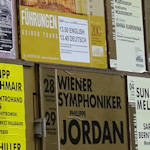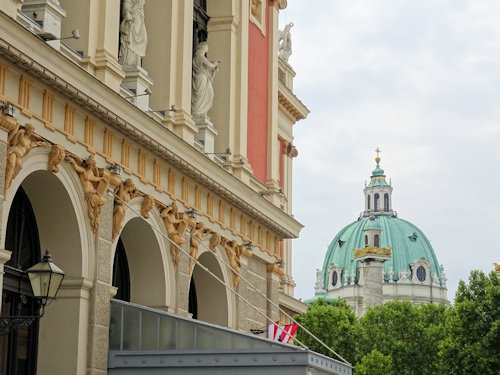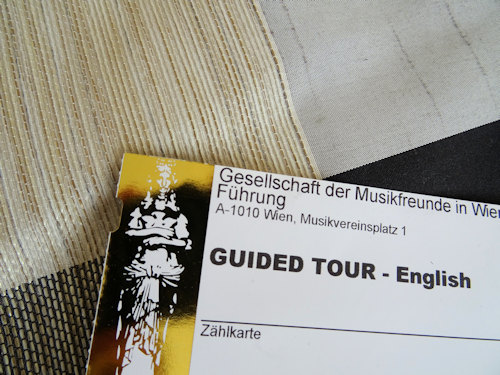
The world’s greatest musicians perform in a huge golden concert hall in Vienna. To see inside, you can buy a ticket to the next performance or simply take the in-house tour of the Musikverein.
- Visit, for example, the two main concert halls in all their decorative glory
- Description of the acoustic elements of the main hall is surprisingly interesting
- Only takes around 45 minutes
- English tours available most days
- Book a concert experience* for Vienna
- See also:
Inside the Musikverein

(The front with a view of Karlskirche church behind)
Stand outside the entrance to the Musikverein building and you can feel music rising out of the ground. It swirls around you, driven by the spirits of those who waved a baton or caressed the keys or strings of an instrument in this hallowed location: Bernstein, Mahler, von Karajan, Liszt, Brahms, Strauss, and all the rest.
(Also, the rehearsal rooms are actually in the basement below you.)
A concert ticket gets you inside. But another alternative is the in-house Musikverein tour, which took me to the entrance foyer, a rehearsal room, and the two main concert halls.
The highlights
My tour began in the largest of the four rehearsal rooms, which also double as small concert halls.
Built in 2004, those rooms are considerably younger than the main 19th-century complex and reveal the location’s high level of professionalism. For example, performers can adjust mounted plates on the walls to fine-tune the acoustics.
Golden ceilings, arches and domes dominate the entrance foyer, where statues of Johann Sebastian Bach and Christoph Willibald Gluck hint further at the prestige and aspirations of the location.

(Written proof of my visit)
Gold is a popular colour at the Musikverein and omnipresent in the two concert halls that complete the short tour.
The Brahms Hall has seating for 600, ochre columns, and a ceiling where barely a space remains untouched by paintbrush and gold paint. The effect is a glorious mix of Hellenic and Renaissance styles.
Brahms filled the post of artistic director of the Musikverein in the 1870s, and his bust sits off to one side of the hall. He keeps an eye on the outside of his old workplace, too: the Brahms statue on Karlsplatz looks directly across at the building.
Elsewhere on the tour, you also see a bust of the legendary pianist Clara Schumann, who gave the very first performance in the Brahms Hall back on January 19th, 1870.
A fire actually broke out in the cloakroom later that night, but they managed to put it out relatively quickly. Nevertheless, smoke damage and similar meant much of the decor had to be redone.
Impressive the Brahms Hall may be, but it’s merely the appetiser to the main course. The famous Großer Musikvereinssaal concert hall fits around 2000 people inside and hosts, for example, the New Year’s Concert.
Huge golden caryatids lead up via columned arches to the fabulous ceiling, where Apollo and the nine muses look down over giant chandeliers onto the audience below. Busts of great composers line the sides: Beethoven, Haydn, Mozart and their ilk.
Performing at the Musikverein must be a double-edged sword.
The inspirational setting might drive you to new heights. But I can imagine feeling some pressure from the spirits of those giants of classical music (past and present) who share the stage with you.

(Entrance ticket for a May 6th, 1875 performance at the Musikvereins-Saal conducted by Richard Wagner in person (my possibly inaccurate translation); Wien Museum Inv.-Nr. 97721; excerpt reproduced with permission under the terms of the CC0 licence)
Our guide touched mostly on the history and functionality of the areas we passed through, with the odd anecdote thrown in for good measure, such as how soldiers used to warm up the main hall before a concert by marching around it at pace.
The guide also offered fascinating insights into all the elements that contribute to the listening experience for concert goers.
For example, those gold caryatids are hollow to support more resonance. And the organ pipes you see form a fake façade that allows changes to the real organ behind without altering the hall’s acoustics.
Tickets and visitor tips
At the time of writing, tours run on several days in the week, with an English-language tour available. Book your ticket direct at the box office or from the official website.
Having seen the Musikverein from the inside, you might want a view from above:
- The Karlskirche church on the square opposite has a panorama terrace as part of the ticketed area. Go up the stone staircase to reach the rooftop area that overlooks the famous concert venue
- The new Wien Museum building on that same square also has a freely-accessible panorama terrace that looks across to the Musikverein
You can complete your classical music venue bingo card by taking a tour of the Staatsoper. That takes you places even those with opera tickets don’t get to see. For other tours of historical buildings in Vienna, try these suggestions.
Incidentally, the Musikverein’s neighbour has recently been restored to its full prestigious glory.
The Künstlerhaus includes, among other institutions, the Albertina Modern museum. This addition to Vienna’s museal landscape hosts exhibitions of contemporary and (surprise) modern art.
How to get to the Musikverein
See the main Musikverein article for travel tips.
Address: Musikvereinsplatz 1, 1010 Vienna